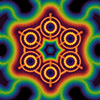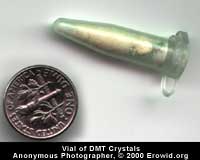DMT
Basics
DESCRIPTION #
N,N-DMT is a psychoactive chemical in the tryptamine family; it causes intense visuals and strong psychedelic mental effects when smoked, injected, snorted, or when taken orally with an MAOI such as harmaline. N,N-DMT is most often called simply "DMT", although this sometimes causes confusion with its more potent chemical cousin 5-MeO-DMT. N,N-DMT is present in over 65 species of plants and has been used traditionally in South America in ayahuasca brews since at least the time of first European contact (around 1500), and archeological evidence suggests its use in snuffs since 2080 BCE. Starting in the mid-1980s, N,N-DMT gained significant notoriety from Terence McKenna's many glowing rants about the strange visions it can precipitate. Following Rick Strassman's research in the early 1990s, and the theories he proposed in his popular 2001 book DMT: The Spirit Molecule (theories that have since been widely promulgated via the Internet), DMT has become even more well known in recent years.
[ Main DMT Vault ]
A standard dose for smoked N,N-DMT is between 15-60 mg. This is generally inhaled in a few successive breaths until the user is unable (or unwilling) to take another hit. Many users report needing to wait an hour or so between attempts, even if effects are not achieved.
Price #
DMT is sometimes sold by the single dose at events for $10-30 USD. Available retail prices range from $100-300 per gram, depending on quality, distance from manufacture, and profit motivation of the distribution chain; in recent years the per-gram prices have come down, and $60 grams have been reported.
N,N-DMT is illegal to possess or sell in the United States (Schedule I). It is controlled by the 1971 United Nation's Convention on Psychotropic Substances and is illegal in most countries.
N,N-Dimethyltryptamine (N,N-DMT) is a naturally occurring chemical in the tryptamine class. It is related structurally to 5-MeO-DMT, bufotenin, psilocybin, and psilocin.
Pharmacology #
DMT affects the serotonin5-HT1A, 5-HT2A and 5-HT2C receptors, the sigma-1 receptors (of which it is the only known endogenous ligand), and the G-protein-coupled trace amine (TA) receptors.
Production #
DMT was first synthesized in 1931 by Canadian chemist Richard H.F. Manske. The synthesis procedure developed in 1954 by M.E. Speeter and W.C. Anthony has been widely parroted in underground publications from the 1960s and 1970s, and additional routes are described in the 1997 book Tryptamines I Have Known and Loved by Alexander and Ann Shulgin. Although illicit DMT produced during that 1960s through the early 1990s was most often created via chemical synthesis, in recent years illicit DMT is much more often extracted from plant sources, often by end-users who have little or no chemistry background. DMT is also produced as a component of ayahuasca and ayahuasca analog brews made using various DMT-containing plants.
N,N-DMT use has been documented as early as the 8th Century ce in snuffs found in burial sites, but its use is believed to be much older. Cohoba snuffs (from the Anadenanthera peregrina tree) were documented in Columbia in the 15th through 19th Centuries. Bufotenin, N,N-DMT, and 5-MeO-DMT were finally identified as the active constituents of cohoba in the mid- to late 1950s.
Terminology / Slang #
The Substance:
DMT; Dimitri; businessman's special trip; spice.
The Experience:
No consistent, common terms. But terms such as 'Blasting Off' or 'Entering the Void' are used.
To quote Terence McKenna, "The feeling of doing DMT is as though one had been struck by noetic lightning. The ordinary world is almost instantaneously replaced, not only with a hallucination, but a hallucination whose alien character is its utter alienness. Nothing in this world can prepare one for the impressions that fill your mind when you enter the DMT sensorium."
The smoked DMT experience is short, but generally incredibly intense. Onset is fast and furious, sometimes compared to being launched from a cannon. It is a fully engaging and enveloping experience of visions and visuals that varies greatly from one individual to the next. Users report visiting other worlds, talking with discarnate entities, profound changes in ontological perspective, fanciful dreamscapes, frightening and overwhelming forces, and complete shifts in perception and identity, followed by an abrupt return to baseline. Because of the nature and intensity of the experience, users are almost always seated or lying down with someone nearby to take the pipe as the experience begins. Intense and varied visuals are common.
The smoked DMT experience is short, but generally incredibly intense. Onset is fast and furious, sometimes compared to being launched from a cannon. It is a fully engaging and enveloping experience of visions and visuals that varies greatly from one individual to the next. Users report visiting other worlds, talking with discarnate entities, profound changes in ontological perspective, fanciful dreamscapes, frightening and overwhelming forces, and complete shifts in perception and identity, followed by an abrupt return to baseline. Because of the nature and intensity of the experience, users are almost always seated or lying down with someone nearby to take the pipe as the experience begins. Intense and varied visuals are common.
Onset #
When smoked, DMT generally reaches full effects within 10-60 seconds of inhalation.
Duration #
The primary effects of N,N-DMT last approximately 5-20 minutes when smoked. For many people there is an additional period of time (1-2 hours) before fully returning to baseline. Some people find DMT experiences difficult to integrate and experience unsettling thoughts and feelings for days after use.
Visual Effects #
Brightly colored, high-res detail, geometric, organic, overlapping, and somewhat kaleidoscopic; may be fast or slow moving, but a sense of motion is often present. Depictions of ayahuasca visions and DMT visions have been featured in the recent films Renegade (2004) and Enter The Void (2009).
PROBLEMS #
One of the primary physical problems encountered with smoked or vaporized N,N-DMT is the harsh nature of the smoke or vapor, which can cause throat and lung irritation. Integration of the smoked/vaporized DMT experience can also cause difficulties for some individuals, especially at higher doses. Challenging integration periods can lead to anxiety, trouble focusing on daily tasks, preoccupation with the experience, difficulty sleeping, etc. Generally these effects dissipate on their own over the course of a few days, but there have been reports of persisting problems.
Contraindications #
- The effects of smoked N,N-DMT are dramatically increased if used by individuals currently taking MAOIs. MAOI drugs include the prescription antidepressants Nardil (phenelzine), Parnate (tranylcypromine), Marplan (isocarboxazid), Eldepryl (l-deprenyl), and Aurorex or Manerix (moclobemide), as well as the harmala alkaloids present in Banisteriopsis caapi (ayahuasca) and Peganum harmala (Syrian rue). Check with your doctor if you are not sure whether your medication is a MAOI.
- Do not stand up. Do not operate heavy machinery. Do Not Drive.
- Individuals currently in the midst of emotional or psychological upheaval in their everyday lives should be careful about choosing to use psychedelics such as N,N-DMT as they can trigger even more difficulty.
- Individuals with a family history of schizophrenia or early onset mental illness should be extremely careful because psychedelics have been known to trigger latent psychological and mental problems.
Addiction Potential #
DMT is neither physically addicting nor likely to cause psychological dependance. As with most substances, some people will use it more frequently than they are comfortable with. There may be a short period of tolerance after DMT use. However, Strassman et al. found in a tolerance study of DMT that four successive high-dose IV injections of DMT administered at 30-minute intervals produced no noticeable tolerance effect.
Long Term Health Problems #
Long Term Health Problems Summary Needed.
Risk of Death #
Risk of Death Summary Needed.
CAUTION & DISCLAIMER #
Erowid Basics pages are summaries of data gathered from site visitors, government documents, books, websites, and other resources. We do our best to keep this information correct and up-to-date, but the field is complex and constantly changing. Information should always be verified through multiple sources.



